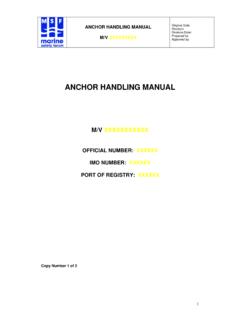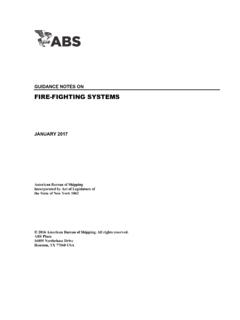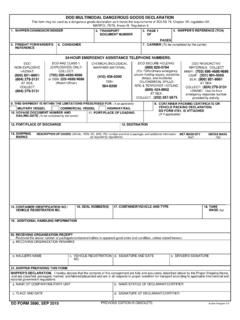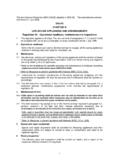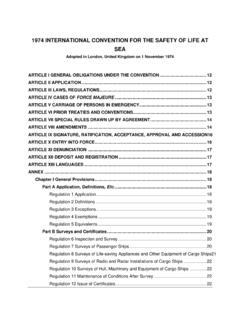Transcription of MARINE TRANSFER OF PERSONNEL
1 MARINE TRANSFER OF PERSONNELW orking together to continuously improve our safety performanceRevision 2, June 2013 STEP CHANGE IN SAFETYMARINE TRANSFER OF PERSONNEL1. OFFSHORE PERSONNEL TRANSFER GUIDELINES ..3 2. VESSEL SELECTION ..63. RISK ASSESSMENT ..95. PASSENGER MONITORING PRIOR TO BOARDING IN PORT ..106. EMBARKATION IN PORT ..117. PASSENGER INDUCTION FOR TRANSIT ..128. PASSENGER EMBARKATION/DISEMBARKATION AT SEA ..139. DISEMBARKATION IN PORT ..1410. PERSONNEL TRANSFER OPERATION (Capsule) ..1511. PERSONNEL TRANSFER OPERATION (Walk to Work) ..18 Appendix 1 Risk Assessment Embarkation Transit Disembarkation ..22 Appendix 2 Risk Assessment PERSONNEL TRANSFER (Capsule) ..31 Appendix 3 Risk Assessment Checklist (Capsule) ..50 Appendix 4 Induction Checklist Example ..56 Appendix 5 Offshore Gangway System TRANSFER Risk Assessment ..59 Appendix 6 Offshore Gangway System Risk Assessment Checklist ..68 Appendix 7 Offshore Crane and Capsule Compliance with LOLER.
2 71 Table of contents1 STEP CHANGE IN SAFETYMARINE TRANSFER OF PERSONNELARR Arrival at fieldDEP Departure from fieldDP Dynamic positioningERRV Emergency response and rescue vesselETA Expected time of arrivalFMEA Failure mode and effect analysisFRC Fast rescue craftFRDC Fast rescue daughter craftGK Gate keeperGO Gangway operatorHSE Health & Safety ExecutiveIMCA International MARINE Contractors AssociationIOC Installation operating companyISPS International Ship and Port Facility SecurityLOLER Lifting Operations and Lifting Equipment RegulationsLSA Life-saving appliancesMCA MARINE and Coastguard AgencyMHC Mechanical handling contractorMOB Vessel mobilisationOAS Offshore access systemOGUK Oil & Gas UKOIM Offshore Installation ManagerPLB Personal locator beaconPM Project managerPPE Personal protective equipmentPTW Permit to workPTM Prior to mobilisationPUWER Provision & Use of Work Equipment RegulationsREP Appointed company rep on vessel (Master if not appointed)SIMOPS Simultaneous operationsSMS Safety management systemSOLAS International Convention for Safety of Life at SeaSTCW International Convention on Standards of Training, Certification and Watchkeeping for SeafarersSWL Safe working loadTBT Task-based trainingTBT Tool box talkTRA Transit to fieldTVO TRANSFER vessel operatorVM Vessel MasterW2W Immediately before, during and after transferGlossary2 STEP CHANGE IN SAFETYMARINE TRANSFER OF IntroductionThe preferred method for the transportation of PERSONNEL offshore in the North Sea is by helicopter.
3 There have been several recent examples of exceptional circumstances where this method of transportation has not been available. Since lack of availability of helicopters is a foreseeable event, the Oil and Gas UK Board have asked Step Change to form a MARINE Safety Work Group to examine other methods of transporting PERSONNEL to offshore Terms of Reference The Terms of Reference provided to the MARINE Safety work groups were to develop guidelines for the safe transportation of PERSONNEL to and from offshore locations by MARINE methods. The guidance herein is for PERSONNEL TRANSFER by a TRANSFER capsule device and gangway walk to work system and includes; Method of TRANSFER ; including all vessel and equipment requirements Risk Assessments Procedures Training PERSONNEL booking, tracking and security Briefings; both onshore and Definition of Exceptional CircumstancesOperators, with the agreement of the MCA, may declare exceptional circumstances in a situation where it is not possible to use helicopters as the primary method of transferring PERSONNEL to or from Offshore Installations and MARINE methods have to be Decision Protocol Flowchart1.
4 OFFSHORE PERSONNEL TRANSFER GUIDELINES3 STEP CHANGE IN SAFETYMARINE TRANSFER OF PERSONNEL4 TRANSFER OF OFFSHORE PERSONNEL DECISION FLOWCHART (ONSHORE) MCA Advised of excep-onal circumstances by DH/OGUK Seek general dispensa-on for mass passenger TRANSFER General dispensa>on issued General dispensa>on not issued. Consider alterna>ve arrangements or mi>ga>ons DH should inform HSE that MARINE TRANSFER is to be undertaken HSE No requirement for HSE acceptance TVO proposes a suitable vessel and facili-es as per sec-on 2. DH to confirm by vessel assurance inspec-on DH to confirm provision for training and briefing for TRANSFER as per sec-on 3 is in place DH provide means of TRANSFER to vessel (capsule) or confirma-on of a fully func-oning Offshore Access System (OAS) DH to provide a container for passenger baggage DH to provide addi-onal PPE, hard hat and PLB as appropriate DH to advise vessel of passenger ETA All above accepted TRANSFER Vessel Operator (TVO) Confirm to DH capability to process passengers at recep-on facility for vessel embarka-on and disembarka-on to DH DH to provide passenger list Provide suitable survival suits.
5 Deliver security checked baggage to vessel/logis-cs provider Accepted Passenger Logis>cs Support (passenger tracking, security, PPE) Advised of excep-onal circumstances by DH DH to provide procedures and risk assessments for method of TRANSFER . These are to be reviewed and agreed Confirm all required cer-fica-on is in place for proposed method of TRANSFER Capsule Method Confirm crane is suitable for liSing PERSONNEL & Crane Operator suitably trained OAS Method Confirm that landing site for OAS is fit for purpose All above accepted Installa>on OIM Conduct TRANSFER opera>ons Duty Holder (DH) Decides that excep-onal circumstances exist and that TRANSFER by helicopter is not possible STEP CHANGE IN SAFETYMARINE TRANSFER OF PERSONNELTRANSFER OF OFFSHORE PERSONNEL DECISION FLOWCHART (OFFSHORE)
6 ERRV Master Confirms to OIM that vessel can provide rescue and recovery facility for the dura9on of the passenger TRANSFER in the prevailing condi9ons Confirms all rescue equipment is fully opera9onal Confirms that all communica9ons are fully opera9onal Confirms that FRC and/or FRDC are ready for immediate launch for the dura9on of passenger TRANSFER All above accepted opera9on to proceed All above not accepted, opera9on aborted TRANSFER Vessel Master Environmental condi9ons acceptable for the expected dura9on of TRANSFER Passenger list exchanged between vessel and installa9on Passengers briefed and agreement received for TRANSFER Order of TRANSFER agreed; to / from vessel Toolbox talks completed Confirms that all communica9ons are fully opera9onal Capsule TRANSFER : All rigging and cer9fica9on checked and in order All PERSONNEL wearing correct PPE 500 metre zone checks completed DP checks completed and fully opera9onal DP pre- set up checks completed and holding posi9on on dedicated heading Offshore Gangway System: System confirmed as fully opera9onal, gangway assistance in place All above accepted opera9on to proceed All above not accepted, opera9on aborted Crane Operator All crane checks complete and crane fully opera9onal Banksman in place on vessel and installa9on Capsule TRANSFER .
7 Test liQ successfully completed All above accepted opera9on to proceed All above not accepted, opera9on aborted Installa=on Environmental condi9ons acceptable for the expected dura9on of TRANSFER Passenger list exchanged between vessel and installa9on Passengers briefed and agreement received for TRANSFER Order of TRANSFER agreed; to/from installa9on Toolbox talks completed Confirms that all communica9ons are fully opera9onal Capsule TRANSFER : LiQing and landing areas and transit areas clear and ready for use All PERSONNEL wearing correct PPE 500 metre zone checks completed Offshore Gangway System: System docking area ready for use, gangway assistance in place All above accepted opera9on to proceed All above not accepted, opera9on aborted Installa=on OIM In overall control of the opera9on and final decision on whether the opera9on can proceed Review of risk assessment with the various par9es, if no acceptable mi9ga9on the opera9on is cancelled un9l condi9ons can be met 5 STEP CHANGE IN SAFETYMARINE TRANSFER OF The Duty Holder will need to ensure that the selection process identifies that the vessel has facilities for the number of passengers expected.
8 This is to be confirmed by the vessel Owner/Operator and by vessel inspection in accordance with the Duty Holder Vessel Assurance System. The vessel selection must ensure that the vessel meets the requirements of the Flag State (MCA for the UK). The vessel selection process must be risk assessed and a checklist in place to ensure that the vessel selected does not suffer rejection of endorsement from the MCA, if applicable. The vessel is to be in class, including compliance with the ISPS Code (if applicable), and must be verified by vessel assurance process. Vessels must be equipped with a fully functioning DP 2 system, in accordance with IMCA guidelines, as applicable to the vessel type. IMCAM182 (The Safe Operation of Dynamically Positioned Offshore Supply Vessels). IMCA M103 [1] (The Design and Operation of Dynamically Positioned Vessels). In addition, the selected vessel must be able to;1. Hold position in set weather limits utilising a maximum of 45% of available Hold position with the available power within a capability plot footprint of 2 metres.
9 Consideration should be given to the DP reference systems available on the selected vessels and their suitability towards the installation they are intended to support. Where applicable the vessel must be verified as permitted to carry passengers over and above the vessels normal manning levels. This may require an exemption from the MCA. Accommodation must, as a minimum, meet the requirements of the Merchant Shipping Act, Statutory Instrument 1997 No. Merchant Shipping (Crew Accommodation) Regulations 1997, and when practicable be of single and or two man cabins. The number of passengers and crew must not exceed the capacity of the LSA on-board in order to meet the requirements of SOLAS. chapter III Regulation 7. The vessel to have adequate arrangements for passenger reception. The vessel must be supplied with the appropriate guidelines, procedures and risk assessments for the method of TRANSFER . The vessel must have a suitable induction process in place to ensure passenger safety and welfare while on board the vessel.
10 English language to be used throughout the operations. Language to be verified in the vessel selection process. A suitable gangway is available that meets the requirements of; Statutory Instrument 1988 No. 1637-The Merchant Shipping (Means of Access) Regulations 1988. Facilities to include the provision of meals if required. This may require the supply of additional stores and provision of additional clean bedding. The vessels may require up-manning and manning levels will need to be agreed with the vessel Owner/Operator. Up-manning may include additional catering and stewarding staff. Facilities will need to include the provision of sea sickness tablets, sick bags and receptacles in VESSEL SELECTION6 STEP CHANGE IN SAFETYMARINE TRANSFER OF PERSONNEL The vessel will need to be provided with a container for passenger baggage. If the container is of an open top type, a waterproof cover is to be provided. The vessel is to be provided with the TRANSFER equipment and certification / documentation if the TRANSFER equipment is not available at the installation.

